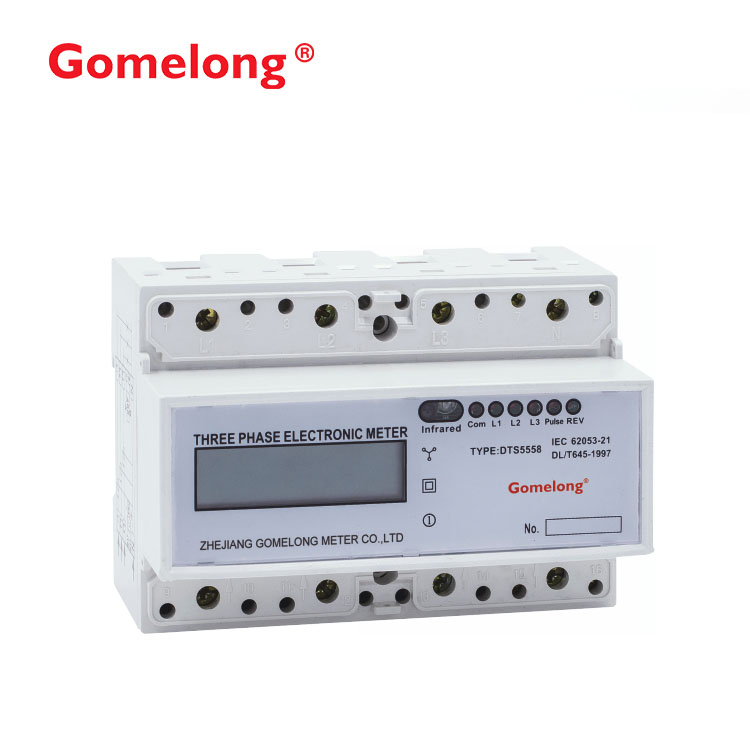DIN Rail Meters: Revolutionizing Electrical Measurement and Control
2025-01-24
In today’s modern electrical systems, accurate measurement and control of electrical parameters are crucial for ensuring safety, efficiency, and performance. One of the key components that help achieve this is the DIN rail meter. These versatile devices offer precise monitoring and control in a wide range of applications, from industrial facilities to residential buildings. In this blog, we’ll dive into what DIN rail meters are, how they work, their benefits, and the various types available.
What is a DIN Rail Meter?
A DIN rail meter is an electronic device that is designed to measure and monitor various electrical parameters, such as voltage, current, power, energy consumption, and frequency. These meters are specifically designed to be mounted on a DIN rail, which is a standardized metal rail used to secure electrical components within electrical panels or enclosures.
DIN rail meters are commonly used in industrial, commercial, and residential settings for energy monitoring, system diagnostics, and load management. Their compact size and modular design make them easy to install and integrate into existing electrical systems.
Why are DIN Rail Meters Important?
DIN rail meters are important because they provide real-time data and accurate measurements, which help ensure optimal performance and safety in electrical systems. Below are a few reasons why these meters are essential:
1. Accurate Monitoring
With a DIN rail meter, you can measure a variety of electrical parameters with high precision. Whether you need to monitor energy consumption, detect potential faults, or optimize load distribution, these meters provide valuable insights into the system's performance.
2. Energy Efficiency
Energy monitoring is one of the main applications of DIN rail meters. By tracking energy usage, users can identify inefficiencies, reduce waste, and implement measures to improve overall energy consumption. This is particularly important for businesses looking to reduce operational costs and meet sustainability goals.
3. Safety
Measuring electrical parameters such as current and voltage is critical for the safety of electrical systems. Over-voltage, over-current, or unbalanced loads can damage equipment or even lead to dangerous situations like electrical fires. DIN rail meters help detect these issues early, allowing for preventive measures to be taken.
4. Cost-Effective
DIN rail meters provide precise data without the need for expensive or complex metering systems. Their modular design and ease of installation make them an affordable solution for monitoring electrical systems. They can also help businesses lower energy costs by identifying opportunities for improvement.
Key Features of DIN Rail Meters
DIN rail meters are equipped with a range of features that make them ideal for various applications. Some of the key features include:
1. Modular Design
The modular design of DIN rail meters allows them to be easily integrated into existing electrical panels and systems. They can be installed alongside other DIN rail-mounted components, such as circuit breakers, contactors, and relays, for a streamlined setup.
2. Real-Time Monitoring
DIN rail meters provide real-time data, enabling users to continuously monitor electrical parameters. This feature is essential for ensuring that the electrical system is operating efficiently and within safe limits.
3. Multiple Measurement Capabilities
Many DIN rail meters are capable of measuring multiple parameters at once, such as:
- Voltage (V)
- Current (A)
- Power (W)
- Energy Consumption (kWh)
- Frequency (Hz)
- Power Factor (pf)
4. User-Friendly Display
DIN rail meters typically feature an LCD or LED display that provides clear readings of the electrical parameters. Some models also come with advanced features such as graphical displays and communication interfaces for remote monitoring.
5. Communication Interfaces
Some advanced DIN rail meters come with communication interfaces such as Modbus, RS-485, or TCP/IP that enable remote monitoring and integration with building management systems or industrial control systems.
Types of DIN Rail Meters
There are several types of DIN rail meters, each designed for specific monitoring applications. Here are a few of the most common types:
1. Energy Meters
Energy meters are designed specifically to measure energy consumption in kilowatt-hours (kWh). They are ideal for monitoring energy usage in residential, commercial, and industrial settings, helping to track and manage electricity costs.
2. Power Meters
Power meters measure the real-time power (in watts) being consumed by electrical devices or systems. These meters help ensure that electrical equipment is operating within its specified power range, avoiding damage or inefficiencies.
3. Multi-Function Meters
Multi-function meters combine the features of energy and power meters, allowing users to measure a variety of electrical parameters, such as voltage, current, power, energy consumption, and power factor. These meters provide a comprehensive overview of the electrical system's performance.
4. Digital Panel Meters
Digital panel meters are designed for use in electrical panels or switchboards, providing digital readings of various electrical parameters. These meters often come with a built-in display and can measure parameters such as voltage, current, and power.
5. Phase Sequence Meters
Phase sequence meters are used to monitor the sequence of phases in three-phase electrical systems. This helps ensure that the system is operating in the correct phase sequence, which is critical for the proper functioning of motors and other equipment.
6. Voltage and Current Meters
Voltage and current meters are designed to measure the individual voltage and current levels in a circuit. These meters are useful for detecting imbalances, faults, or other issues that could compromise the electrical system’s integrity.
Applications of DIN Rail Meters
DIN rail meters have a wide range of applications across various industries and sectors. Here are some of the most common applications:
1. Industrial Applications
In industrial environments, DIN rail meters are used to monitor the energy consumption of machines, motors, and production lines. By tracking power usage and detecting inefficiencies, businesses can optimize energy consumption, reduce downtime, and enhance overall productivity.
2. Commercial Buildings
For commercial buildings, DIN rail meters help track and manage energy usage across different systems, including HVAC, lighting, and electrical equipment. These meters provide data that can be used to reduce operational costs and meet energy efficiency standards.
3. Renewable Energy Systems
In solar, wind, or hybrid renewable energy systems, DIN rail meters can be used to monitor energy generation, consumption, and storage. They provide real-time data that helps optimize the performance of renewable energy systems.
4. Residential Use
In residential applications, DIN rail meters can be used to monitor energy consumption, helping homeowners track electricity usage and lower their energy bills.
5. Data Centers and IT Infrastructure
Data centers rely on precise monitoring of electrical parameters to ensure that critical IT equipment operates smoothly and without interruption. DIN rail meters are used to measure power usage, detect faults, and prevent overloads.
Conclusion
DIN rail meters are an essential part of modern electrical systems, offering reliable and accurate monitoring of electrical parameters. With their modular design, ease of installation, and wide range of measurement capabilities, they provide valuable insights that help optimize energy consumption, improve safety, and reduce costs. Whether in industrial, commercial, or residential applications, DIN rail meters play a crucial role in maintaining the efficiency and reliability of electrical systems.



